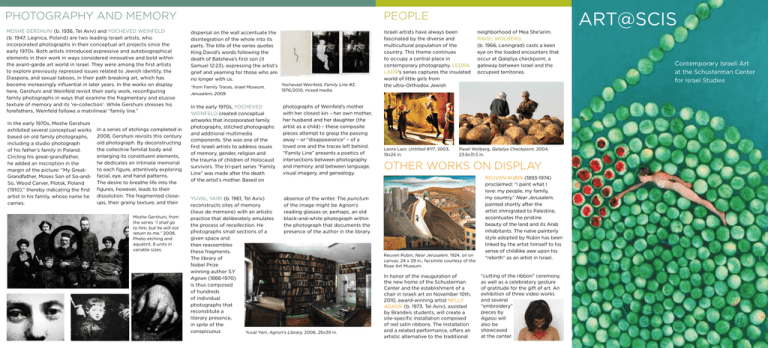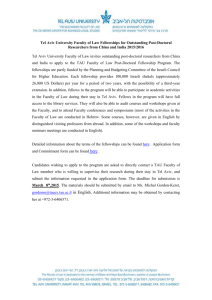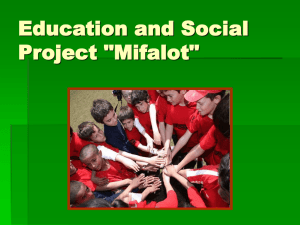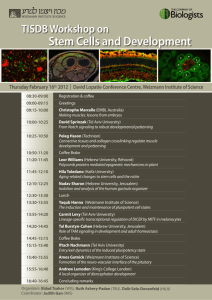ART@SCIS PHOTOGRAPHY AND MEMORY
advertisement

PHOTOGRAPHY AND MEMORY MOSHE GERSHUNI (b. 1936, Tel Aviv) and YOCHEVED WEINFELD (b. 1947, Legnica, Poland) are two leading Israeli artists, who incorporated photographs in their conceptual art projects since the early 1970s. Both artists introduced expressive and autobiographical elements in their work in ways considered innovative and bold within the avant-garde art world in Israel. They were among the first artists to explore previously repressed issues related to Jewish identity, the Diaspora, and sexual taboos, in their path breaking art, which has become increasingly influential in later years. In the works on display here, Gershuni and Weinfeld revisit their early work, reconfiguring family photographs in ways that examine the fragmentary and elusive texture of memory and its ‘re-collection’. While Gershuni stresses his forefathers, Weinfeld follows a matrilineal “family line.” In the early 1970s, Moshe Gershuni exhibited several conceptual works based on old family photographs, including a studio photograph of his father’s family in Poland. Circling his great-grandfather, he added an inscription in the margin of the picture: “My GreatGrandfather, Moses Son of So-andSo, Wood Carver, Plotsk, Poland (1910),” thereby indicating the first artist in his family, whose name he carries. In a series of etchings completed in 2008, Gershuni revisits this century old photograph. By deconstructing the collective familial body and enlarging its constituent elements, he dedicates an intimate memorial to each figure, attentively exploring facial, eye, and hand patterns. The desire to breathe life into the figures, however, leads to their dissolution. The fragmented closeups, their grainy texture, and their Moshe Gershuni, from the series “I shall go to him, but he will not return to me,” 2008, Photo-etching and aquatint, 8 units in variable sizes. PEOPLE dispersal on the wall accentuate the disintegration of the whole into its parts. The title of the series quotes King David’s words following the death of Batsheva’s first son (II Samuel 12:23), expressing the artist’s grief and yearning for those who are no longer with us. *from Family Traces, Israel Museum, Jerusalem, 2009. In the early 1970s, YOCHEVED WEINFELD created conceptual artworks that incorporated family photographs, stitched photographs and additional multimedia components. She was one of the first Israeli artists to address issues of memory, gender, religion and the trauma of children of Holocaust survivors. The tri-part series “Family Line” was made after the death of the artist’s mother. Based on Yocheved Weinfeld, Family Line #3, 1976/2010, mixed media photographs of Weinfeld’s mother with her closest kin – her own mother, her husband and her daughter (the artist as a child) – these composite pieces attempt to grasp the passing away – or “disappearance” – of a loved one and the traces left behind. “Family Line” presents a poetics of intersections between photography and memory, and between language, visual imagery, and genealogy. YUVAL YAIRI (b. 1961, Tel Aviv) absence of the writer. The punctum reconstructs sites of memory of the image might be Agnon’s (lieus de mémoire) with an artistic reading glasses or, perhaps, an old practice that deliberately emulates black-and-white photograph within the process of recollection. He the photograph that documents the photographs small sections of a presence of the author in the library. given space and then reassembles these fragments. The library of Nobel Prize winning author S.Y Agnon (1888-1970) is thus composed of hundreds of individual photographs that reconstitute a literary presence, in spite of the conspicuous Yuval Yairi, Agnon’s Library, 2006, 26x39 in. Israeli artists have always been fascinated by the diverse and multicultural population of the country. This theme continues to occupy a central place in contemporary photography. LEORA LAOR’s series captures the insulated world of little girls from the ultra-Orthodox Jewish Leora Laor, Untitled #117, 2003, 18x24 in. neighborhood of Mea She’arim. PAVEL WOLBERG (b. 1966, Leningrad) casts a keen eye on the loaded encounters that occur at Qalqilya checkpoint, a gateway between Israel and the occupied territories. Pavel Wolberg, Qalqilya Checkpoint, 2004, 23.6x31.5 in. OTHER WORKS ON DISPLAY Reuven Rubin, Near Jerusalem, 1924, oil on canvas, 24 x 29 in., facsimile courtesy of the Rose Art Museum. In honor of the inauguration of the new home of the Schusterman Center and the establishment of a chair in Israeli art on November 10th, 2010, award-winning artist NELLY AGASSI (b. 1973, Tel Aviv), assisted by Brandeis students, will create a site-specific installation composed of red satin ribbons. The installation and a related performance, offers an artistic alternative to the traditional REUVEN RUBIN (1893-1974) proclaimed: “I paint what I love: my people, my family, my country.” Near Jerusalem, painted shortly after the artist immigrated to Palestine, accentuates the pristine beauty of the land and its Arab inhabitants. The naïve painterly style adopted by Rubin has been linked by the artist himself to his sense of childlike awe upon his “rebirth” as an artist in Israel. “cutting of the ribbon” ceremony, as well as a celebratory gesture of gratitude for the gift of art. An exhibition of three video works and several “embroidery” pieces by Agassi will also be showcased at the center. ART@SCIS Contemporary Israeli Art at the Schusterman Center for Israel Studies LOCAL LANDSCAPES VIDEO ART “Small though it is, Israel has been providing The salt solution of the Dead Sea enables everything to float on its illusive surface. The spiral gradually becomes a thin green line abandoning the viewer.” more than its share of artistic talent to the global art circuit, especially where video and performance art are concerned…” —Roberta Smith, New York Times, August 11, 2010 The Schusterman Center for Israel Studies, located on the third floor of the Mandel Center for the Humanities at Brandeis University, strives to promote the critical study of Israeli art through rigorous academic scholarship, teaching, artist residencies, and the exhibition of contemporary art. The center will provide an inclusive venue for the display of art, photography and videos by Israeli artists from diverse ethnic, cultural and religious backgrounds. Art@SCIS will be integrated into the teaching curriculum, providing primary visual sources for the study of Israeli art, society and culture. Q Acknowledgements: We are deeply grateful to the Charles and Lynn Schusterman Family Foundation for its generosity to the Center and for the gift of Israeli artworks to create our collection. This exhibition was curated with Rivka Saker and Marge Goldwater. Special thanks to Moshe Gershuni, Yocheved Weinfeld, Nelly Agassi, Sigalit Landau, Doron Solomons, Yael Bartana and Guy Ben-Ner for their generosity. We are grateful to Sergio Edelstein of the Center for Contemporary Art, Tel Aviv; Yael Reinharz of Artis, New York; our colleagues at Fine Arts and the Rose Art Museum; and to the students of Brandeis University. Sigalit Landau, Cycle Spun (Dead See), 2007, 11:39 minutes SIGALIT LANDAU (b. 1969, Jerusalem) creates poignant videos in which her body interacts with the Israeli landscape in poetic and symbolic ways. Dead See (2007) offers a lyrical image of Landau floating in the Dead Sea, ensconced in a slowly unraveling spiral of green watermelons. The work conjures up a dialogue with Robert Smithson’s iconic Spiral Jetty (1970), but also with Jungian notions of the Self, spiraling inward introspectively and outward, opening up to embrace the world. The artist described the work as: “a cord of two hundred and fifty meters penetrates five hundred water melons forming a six meter spiral raft in the saturated salt waters of the Dead Sea… I am floating locked inside the spiral layers between the center and the periphery of the sweet raft. I am reaching out against the direction of the turning raft towards a small area in the spiral where the fruit is wounded, red and exposed like myself to the sting of the salt. YAEL BARTANA (b. 1970, Afula) filmed Trembling Time (2001) from a bridge over the Ayalon Highway in Tel Aviv as the sirens marking Israel’s National Memorial Day sounded. She captures the eerie moments when everything comes to a tense stand still and quotidian time seems to be suspended. In a recent interview Bartana elaborates: “What I was most interested in was the actual moment in which everything stops. There is a large system behind this moment of stopping. That’s why there is also a feeling of stretching time. And that slowly, slowly, slowly everything comes to a halt. It’s very monumental in a way.”* London) is a video artist whose artistic practice in the last decade has been inextricably connected to his experience as a professional news editor, the materials to which he is exposed in this capacity, and the ethical problems posed by this practice. In Shopping Day (2006), Solomons directly addresses the language of advertising and its limited filmic lexicon. Using his editorial skill and editing language, he manages to subvert the message and undermine consumerism.* * from Doron Solomons, Center for Contemporary Art, Tel Aviv, 2006. *from Yael Bartana: Short Memory, Center for Contemporary Art, Tel Aviv, 2008. DORON SOLOMONS (b. 1969, Doron Solomons, Shopping Day, 2006, 5 minutes Yael Bartana, Trembling Time, 2001, 6:20 minutes *Courtesy of the artists and the Center for Contemporary Art, Tel Aviv. Guy Ben-Ner, Elia - A Story of an Ostrich Chick, 2003, 22:30 minutes In Elia—A Story of an Ostrich Chick GUY BEN-NER (b. 1969, Ramat Gan), his wife, Nava, and his two young children, Elia and Amir, play the parts of a family of ostriches migrating to find better feeding grounds. (Ben-Ner had recently brought his family from Tel Aviv to New York to attend the M.F.A. program at Columbia University). The video follows the family, dressed in ostrich costumes, as they wander through Manhattan’s Riverside Park. Mimicking the format of nature documentaries, the video features a voice-over narrative which translates the emotions and movements of the family for the audience. Like the narrator, who anthropomorphizes the creatures with his descriptions, Ben-Ner also collapses human and animal. The video seems to poke fun at conventional ideas of familial relationships and how they are socially perceived and dictated. At the same time, the work attempts to resolve the frictions within the family unit, much as children do through play.* *from Guy Ben-Ner: Thursday the 12th, MASS MoCA Exhibition Brochure, May 2009-March 2010. Photographs often reflect the complex, sometimes contradictory, tales imbedded in the local landscape. YOSSI BREGER (b. 1960, Montreuil Sous Bois, France) presents a nostalgic image of the Yarkon River in Tel Aviv that suggests a yearning for green, waterabundant faraway lands. DOR GUEZ (b. Jerusalem) creates a series of nocturnal images of the ruins of Lydd (the Arab name for the town of Lod). The beauty of the photograph, simultaneously hides and exposes the remnants of a Palestinian home destroyed and depopulated in 1948. EFRAT SHALEM (b. 1971) displays a compelling juxtaposition of geometric and organic shapes, revealing the presence of beauty even in this mundane urban setting. Yossi Breger, The Yarkon River, 2001, 36x44 in. Dor Guez, Lydd Ruins 5, 2009, 31.5x39.4 in. Efrat Shalem, Untitled, 1999, 40x48 in.




